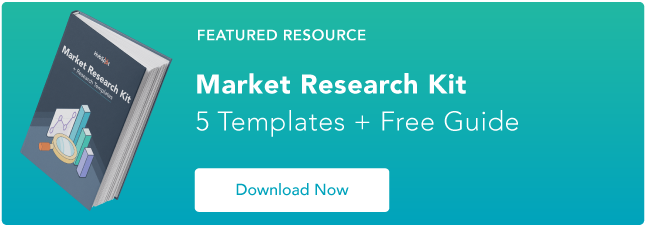In college, I interned at a MarTech company that sold email marketing optimization software. With their software, brands could finally gain visibility into their email program’s deliverability rate or inbox placement, which most email service providers, like Constant Contact or MailChimp, can’t do.

The business’ largest revenue stream was a channel partner program that enabled email service providers to sell my old company’s software to their own customers. And one day, at an all-hands meeting, our CEO showed us a slide that listed every single email service provider we partnered with and the amount of customers they all had.
He told us this was our total addressable market. Then, he showed us a slide of how much of the market we had captured — it was a single digit percentage. Even though we generated $100 million in revenue per year, we were shocked at how little of the market we had secured. But it also helped us realize that we still had plenty of room to grow, which motivated us to win as much of the market as possible.
.png)
Free Market Research Kit
5 Research and Planning Templates + a Free Guide on How to Use Them in Your Market Research
- SWOT Analysis Template
- Survey Template
- Focus Group Template
- And More!
Download Free
All fields are required.
.png)
Whether you want to start a new company and gauge its industry’s profit potential or forecast a realistic revenue growth goal for your business, measuring your total addressable market is a crucial first step you must take. To help you do this, we’ve put together a guide that’ll teach you exactly what total addressable market is and the best way to calculate it.
Total Addressable Market (TAM)
Total addressable market or TAM refers to the total market demand for a product or service. It’s the most amount of revenue a business can possibly generate by selling their product or service in a specific market.
Unless they're a monopoly, most companies can’t capture the total addressable market for their product or service. Even if a company just has one competitor, it would still be extremely difficult for them to convince an entire market to only buy their product or service.
That’s why most companies also measure their serviceable available market to determine how many customers they can realistically reach with their marketing and sales channels. Additionally, they gauge their share of market to understand the size of their actual target market.
However, total addressable market is still useful because businesses can use TAM to objectively estimate a specific market’s potential for growth.
How to Calculate TAM
There are three ways to calculate your business' total addressable market.
1. Top-Down
The top-down approach uses industry data, market reports, and research studies to identify the TAM. In this approach, you might use industry data from Gartner or Forrester to identify which subsections of your industry align with your goals and offering — and just how big those subsections are.
However, there are limitations here. Data generated by industry groups may not always be kept up to date and may not reflect niche elements of your market. You may want to hire a market research consulting firm to conduct fresh research that is focused on your need areas.
2. Bottom-Up
The bottom-up approach to TAM calculation is based on previous sales and pricing data. First, multiply your average sales price by your number of current customers. This will yield your annual contract value. Then, multiply your ACV by the total number of customers. This will yield your total addressable market. Let's see what this looks like in an example.

Say you sell scuba fins to dive shops in the state of California. You might sell an average of 60 pairs of fins, at $35/pair, to dive shops in California. 60 multiplied by $35 equals an ACV of $2,100. Then, you'd multiply your ACV ($2,100) by the total number of dive shops in California (125) for a total addressable market of $262,500.
3. Value-Theory
The value-theory approach is based on how much value consumers receive from your product/service and how much they're willing to pay in the future for that product/service.
To return to our scuba example, let's say you manufacture a type of fin that's lighter than your competitors and has patented technology that makes them easier to get off than anything else in the market. You'd identify your value-theory by estimating how much dive shops would be willing to pay to carry your superior product. If normal fins are being sold at $35 a pair, would dive shops pay $40 or even $45 for a pair of your ultra-lightweight fins?
After you calculate your total addressable market, it’s time to determine whether it’s worth entering the industry or not.
An industry with a market size ranging from $30 million to $200 million per year might be worth entering. However, if the industry’s market size is under $5 million per year or over $1 billion per year, it’s probably not.
In both situations, it’d be challenging to persuade investors to back your company -- an industry with a market size of $5 million per year would likely be too niche and an industry with a market size over $1 billion would likely be too saturated.
Know Your TAM Before You Take Action
Starting a business or projecting next year's revenue growth is always thrilling. But if you want to follow a realistic path toward success, you need to first understand what's actually possible. So let your total addressable market be your North Star and guide you through a journey that's rooted in reality, not hype.
![→ Download Now: Market Research Templates [Free Kit]](https://no-cache.hubspot.com/cta/default/53/6ba52ce7-bb69-4b63-965b-4ea21ba905da.png)




![SWOT Analysis: How To Do One [With Template & Examples]](https://www.hubspot.com/hubfs/marketingplan_20.webp)

![How to Run a Competitor Analysis [Free Guide]](https://www.hubspot.com/hubfs/Google%20Drive%20Integration/how%20to%20do%20a%20competitor%20analysis_122022.jpeg)
![5 Challenges Marketers Face in Understanding Audiences [New Data + Market Researcher Tips]](https://www.hubspot.com/hubfs/challenges%20marketers%20face%20in%20understanding%20the%20customer%20.png)

